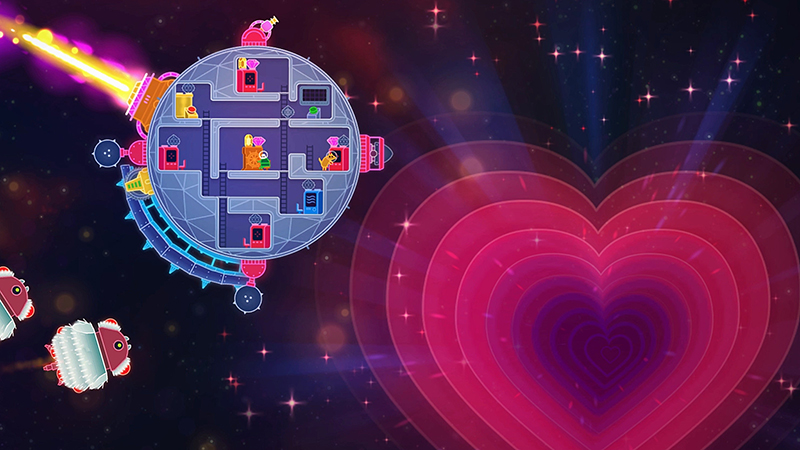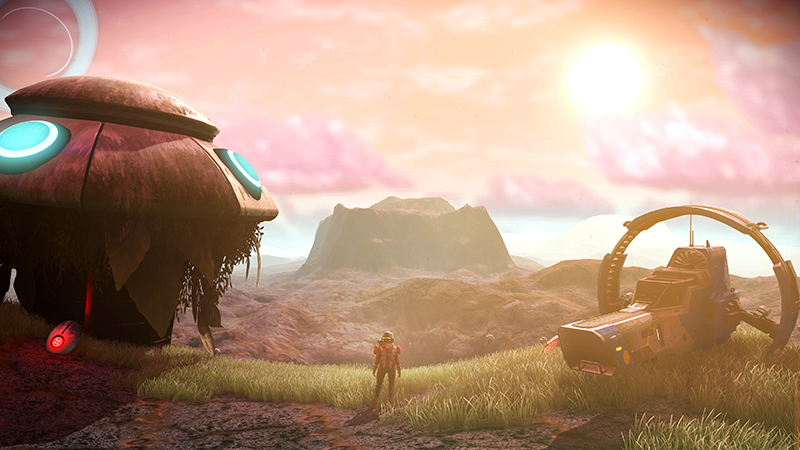Stellar Outer Space Board and Video Games
A trio of games that complement this year’s Collaborative Summer Reading theme emphasize the need for players to work together when faced with galactic danger.
Outer space is almost a perfect setting for a game: it suggests the potential for friendly (or hostile) contact with alien life, the physics of gravity, and the mechanics of managing limited resources to survive. One can trace these threads back to Spacewar! (1962) and Asteroids (1979) to modern classics such as Cosmic Encounter (2008) and FTL: Faster Than Light (2012). Below are three titles which complement this year’s Collaborative Summer Reading theme, "A Universe of Stories,” and also emphasize, through their mechanics, the need for players to work together when faced with galactic danger.

Mole Rats in Space ($19.99; Gr 1 Up) is a cooperative tabletop game created by renowned game designer Matt Leacock, known for Pandemic and Forbidden Island. In Mole Rats, the complex social and strategic elements of those two games have been streamlined, but the game still poses a fun and formidable challenge for a range of players, making it a great choice for intergenerational play.
Players assume the role of mole rats attempting to avoid snakes that have invaded their space station, while collecting four items (a map, radish, toothbrush, and duct tape), and finally, fleeing together by reaching the escape pod in the middle of the board.
Success entirely depends on students working together, making this game an excellent tool for encouraging social-emotional learning and cooperative problem solving. The rules also reinforce a feeling of urgency and high stakes for players within a safe environment: if they run out of cards or one of their crew is bitten by a snake twice, everyone loses, but they can reset the board and try again.
Another notable feature of the game is that cards are played face up, meaning more advanced players can strategize by anticipating the turns of their teammates. The card illustrations also intelligently rely on color coding to express rules and movement, rather than being language dependent. For instance, a card with a rainbow-colored mole rat and three arrows means a player can move any of the players’ pieces three spaces.
Lastly, Mole Rats in Space is a variation on the ancient board game Snakes and Ladders (dating back to the 2nd century A.D. and adapted as the popular Chutes and Ladders by Milton Bradley in 1943), making it a fascinating example of iteration in the history of game design. VERDICT A challenging tabletop game that encourages social-emotional development and collective problem solving.

In its aesthetic, Lovers in a Dangerous Spacetime (Asteroid Base. $19.99; Gr 6 Up) draws from the lighter side of anime (think of shows like Sailor Moon), presenting a science fiction universe filled with pinks, purples, and space bunnies—who shoot rainbows out of their chest to open locked gates.
What makes this cooperative, multiplayer videogame particularly challenging and fun to play with middle school students is the way in which it implicitly demands that players work together to pilot a giant, unwieldy spacecraft through a hostile world.
Although a single player (with a computer-controlled pet) can take on this task, this title shines when four players are communicating and working together completely in sync, warning each other of incoming dangers and cheering when they finally clear a level.
Rather than giving players the feeling of control, Lovers in a Dangerous Spacetime allows only one player to command each part of the spaceship at a time, by moving their characters to an open terminal. While the ship’s abilities can change through upgrades, these are generally split between the engines, laser guns, shield, and powerful Yamato cannon.
An inexperienced team of students may initially argue over roles, but after a mission failure, they will generally begin delegating and volunteering for tasks. For instance, they may begin taking votes on upgrades or talking through the more difficult sequences.
The game excels in presenting players with a problem, which encourages healthy social and emotional interactions, while avoiding a prescriptive or didactic message about the importance of teamwork. That said, it does provide one helpful visual cue in the form of a cartoon cloud that appears when two players try accessing a terminal at the same time.
Interestingly, the awkward and segmented nature of the game’s controls ensures that no one player will ever feel complete mastery over the dangers of outer space. However, this can be an empowering realization for students. VERDICT A fun game that implicitly asks students to work as a team when faced with cosmic dangers.

Hello Games launched No Man’s Sky ($19.99 to $49.99; Gr 9 Up) to exceedingly high expectations three years ago. This was a game that promised a procedurally generated universe filled with an estimated “18 quintillion planets” to discover. Additionally, each would have its own climate and unique plants and animals to explore on foot.
Many players thrilled at the sense of scale, while others found it expansive but desolate. This was further complicated by the fact that some features seemed to be only partially implemented at release.
Fast forwarding to the present, the developers have continued to build upon the original game, adding large, free content updates that include: base building, vehicles, procedurally generated missions, multiplayer underwater environments, and more varied biomes. Each major update has generated excitement among players and positive reevaluations by critics.
Its latest update, Beyond, promises an even more immersive universe with a virtual reality mode as well as improvements to the social and multiplayer aspects of the game, all of which will be available as a free download in summer 2019.
Teens with experience with Minecraft (or similar titles) may immediately gravitate towards the crafting and base building aspects of the game. Other students will be drawn to recruiting alien allies, documenting the new animals and plants that they discover, or setting up trade routes.
In interviews, the developers have commented that they want players to feel as if they were stepping into the unreal landscapes of a science fiction paperback. Even from its earliest version, No Man’s Sky seems to have achieved that feeling of entering the unknown. VERDICT A fascinating space exploration game, which continues to evolve and expand with each free update.
See also Thomas Knowlton's "Finding Empathy Through Games" and "Celebrating National Game and Puzzle Week."
Thomas Knowlton is School Outreach Librarian for MyLibraryNYC at the New York Public Library, and the creator of NYPLarcade @nyplarcade. Follow him @thomasknowlton.
RELATED
The job outlook in 2030: Librarians will be in demand
The job outlook in 2030: Librarians will be in demand
ALREADY A SUBSCRIBER? LOG IN
We are currently offering this content for free. Sign up now to activate your personal profile, where you can save articles for future viewing






Add Comment :-
Comment Policy:
Comment should not be empty !!!
Pete Kent
Great article had a great time reading it. Kid are truly the future. https://www.deeponionweb.comPosted : Nov 12, 2019 02:25